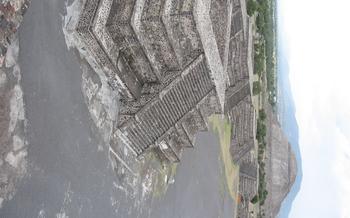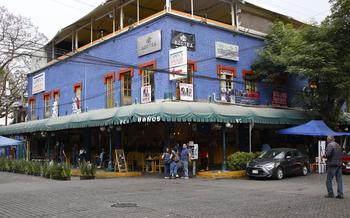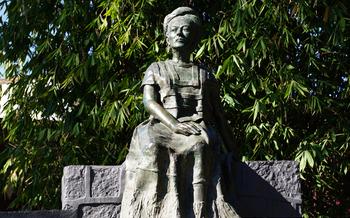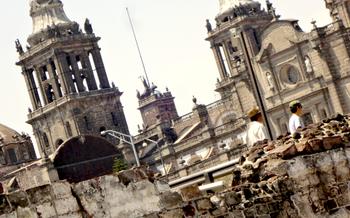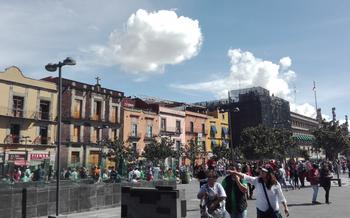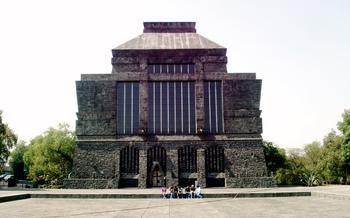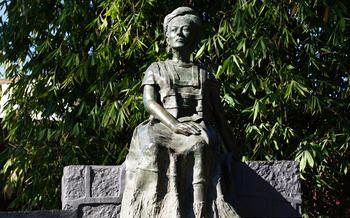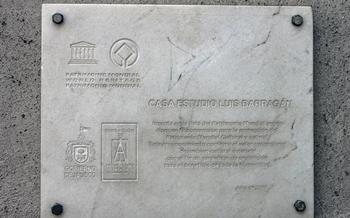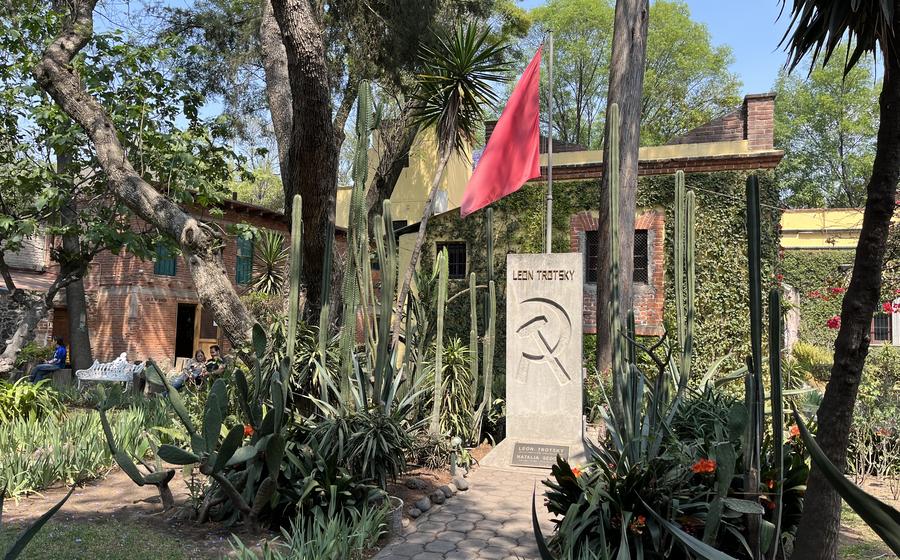
Museo Leon Trotsky
- Museo Leon Trotsky: A Glimpse into the Life of a Revolutionary
- Exploring the Museum Grounds: A Journey Through History
- A Multimedia Experience: Bringing History to Life
- Delving into Trotsky's Study: A Place of Reflection
- Unveiling the Secret Tunnel: A Hidden Passageway
- Exploring Trotsky's Bedroom: A Place of Rest and Contemplation
- The Courtyard: A Place of Tranquility and Reflection
- The Dining Room: A Place of Gathering and Conversation
- The Living Room: A Place of Comfort and Connection
- The Kitchen: A Place of Sustenance and Simplicity
- The Trotsky Family: A Complex and Dynamic Unit
- Museo Leon Trotsky: A Symbol of Resilience
- Practical Information for Visitors: Planning Your Trip
- Insider Tip: Uncovering Hidden Gems
Museo Leon Trotsky: A Glimpse into the Life of a Revolutionary
Leon Trotsky, a prominent figure in the Russian Revolution, found refuge in Mexico City during his exile. The Museo Leon Trotsky, located in the Coyocoan neighborhood, offers a unique glimpse into the life and legacy of this controversial revolutionary. This museum, housed in the very house where Trotsky lived and was assassinated, stands as a testament to his impact on world history.
The museum's architectural features are as captivating as its exhibits. The house, a blend of colonial and modern styles, reflects Trotsky's eclectic tastes and his desire for a peaceful retreat. Visitors can marvel at the vibrant blue exterior, the spacious garden, and the intricate murals adorning the walls, all of which contribute to the museum's distinctive atmosphere.
Inside the museum, visitors embark on a journey through Trotsky's life and work. Exhibits showcase his early years in Russia, his role in the Bolshevik Revolution, his exile from the Soviet Union, and his eventual assassination in Mexico. Through photographs, documents, and personal belongings, the museum paints a vivid picture of Trotsky's unwavering commitment to revolution and his complex relationship with other revolutionary figures, including Vladimir Lenin and Joseph Stalin.
Exploring the Museum Grounds: A Journey Through History
Beyond the walls of the house, the museum's tranquil garden beckons visitors to explore the serene surroundings that once provided solace to Leon Trotsky and his family. Designed with meticulous care, the garden boasts a variety of native plants and flowers, creating a vibrant tapestry of colors and scents. Each element of the garden holds symbolic significance, reflecting Trotsky's deep connection to nature and his belief in the power of beauty to inspire and uplift the human spirit.
Among the highlights of the garden are several sculptures and monuments dedicated to Trotsky. A striking bronze bust of the revolutionary stands proudly in the center, capturing his determined gaze and unwavering spirit. Other sculptures depict scenes from Trotsky's life, immortalizing key moments and achievements. These works of art serve as poignant reminders of Trotsky's legacy and the impact he had on the course of history.
The garden also houses the museum's library and research center, a treasure trove of knowledge for scholars and history enthusiasts alike. Here, visitors can delve into Trotsky's vast collection of books, manuscripts, and personal papers, gaining a deeper understanding of his political thought, literary prowess, and revolutionary zeal. The library's resources provide a comprehensive overview of Trotsky's life and work, making it an invaluable resource for researchers and anyone interested in exploring the complexities of this enigmatic figure.
A Multimedia Experience: Bringing History to Life
The Museo Leon Trotsky offers a captivating multimedia experience that brings Leon Trotsky's life and ideas to life. Interactive exhibits and immersive displays engage visitors, providing a deeper understanding of Trotsky's revolutionary journey. Through virtual reality simulations, visitors can step into the shoes of Trotsky and experience key moments from his life, such as his participation in the Russian Revolution or his exile in Mexico. Touchscreen displays offer an in-depth exploration of Trotsky's writings, speeches, and political campaigns. These multimedia elements transform the museum into a dynamic and interactive space, creating a lasting impression on visitors.
One visitor described her experience with the multimedia exhibits: "The virtual reality simulation of the Russian Revolution was incredibly immersive. I felt like I was transported back in time, witnessing the events unfold alongside Trotsky. It was a truly unforgettable experience."
Another visitor commented on the impact of the interactive displays: "I was particularly drawn to the touchscreen display that allowed me to explore Trotsky's writings in detail. The interactive timeline helped me understand the evolution of his political thought and how his ideas shaped the course of history."
These multimedia experiences not only enhance visitors' understanding of Trotsky's life and legacy but also create a personal connection, allowing them to engage with history in a meaningful and memorable way.
Delving into Trotsky's Study: A Place of Reflection
Trotsky's original study, preserved within the museum, offers a glimpse into his intellectual and creative processes. The room is filled with his personal belongings, including his desk, chair, bookshelves, and writing implements. Visitors can see the manuscripts of his unfinished works, as well as the typewriter he used to compose them.
The study also contains a number of artifacts that shed light on Trotsky's political and personal life. There are photographs of his family and friends, as well as souvenirs from his travels around the world. The walls are adorned with revolutionary posters and propaganda, reflecting Trotsky's lifelong commitment to socialism.
Trotsky's study is a place of reflection and contemplation. It is here that he developed his theories of permanent revolution and the dictatorship of the proletariat. It is also here that he wrote his autobiography, My Life, and his unfinished work, The Revolution Betrayed.
The study is a reminder of Trotsky's prolific output as a writer and thinker. It is also a reminder of his tragic fate. Trotsky was assassinated in 1940 by an agent of Stalin. He was 60 years old.
The preservation of Trotsky's study is a testament to his enduring legacy. It is a place where visitors can learn about his life and work, and where they can reflect on the power of ideas to change the world.
Unveiling the Secret Tunnel: A Hidden Passageway
Beneath the surface of the Museo Leon Trotsky lies a hidden passageway that adds an air of intrigue to the revolutionary's life story. This secret tunnel, constructed for safety purposes, served as a covert escape route for Trotsky and his family during times of danger. Imagine the tension and secrecy that unfolded within these narrow walls as they sought refuge from potential threats.
The tunnel's existence is a testament to the tumultuous period in which Trotsky lived. It's a reminder of the constant threats he faced as a political dissident and the precautions he had to take to protect himself and his loved ones. Visitors to the museum can experience the thrill of exploring this hidden passageway, gaining a deeper understanding of Trotsky's life and the challenges he faced.
As you venture through the tunnel, let your imagination transport you back in time. Picture Trotsky and his family navigating the dimly lit corridor, their footsteps echoing in the silence. Imagine the sense of urgency and relief they felt as they made their way to safety. The tunnel becomes a tangible link to the past, allowing visitors to connect with the human side of this historical figure.
Whether you're a history buff, an architecture enthusiast, or simply curious about the life of Leon Trotsky, exploring the secret tunnel at the Museo Leon Trotsky is a unique and unforgettable experience. It's a chance to uncover a hidden part of history and gain a deeper appreciation for the complexities of this iconic revolutionary.
Exploring Trotsky's Bedroom: A Place of Rest and Contemplation
Leon Trotsky's bedroom, preserved within the museum, offers a glimpse into his private life and daily routine. The room is simple yet functional, reflecting Trotsky's pragmatic nature. The bed, desk, and other furnishings are modest, but well-maintained, suggesting a man who valued comfort without extravagance.
Personal items, such as Trotsky's eyeglasses, writing instruments, and books, add a touch of intimacy to the space. The books on his bedside table provide insight into his intellectual pursuits, ranging from political theory to literature and history. Visitors can almost imagine Trotsky sitting at his desk, working late into the night, surrounded by the tools of his trade.
Historical anecdotes and stories about Trotsky's daily routine and writing habits further enhance the visitor's understanding of the man behind the revolutionary. Visitors learn about Trotsky's regimented schedule, his love of reading, and his dedication to his work. They also gain a glimpse into his personal struggles, such as his insomnia and his longing for his homeland.
Exploring Trotsky's bedroom is a unique opportunity to connect with the human side of a complex and controversial figure. Visitors leave with a deeper appreciation for Trotsky's intellect, his dedication to his cause, and the personal sacrifices he made in his pursuit of a better world.
The Courtyard: A Place of Tranquility and Reflection
In the heart of the Museo Leon Trotsky, visitors will find a peaceful oasis, a courtyard where Trotsky and his family sought solace and tranquility. Surrounded by lush greenery, blooming flowers, and towering trees, this serene space invites visitors to pause and reflect on the life and work of the revolutionary.
The courtyard, like many other elements of the museum, is imbued with symbolism. The plants and trees, carefully chosen by Trotsky himself, represent his deep connection to nature and his belief in the power of growth and renewal. Sculptures and monuments dedicated to Trotsky and other revolutionary figures stand as silent witnesses to the struggles and triumphs of the past.
Visitors can wander through the courtyard, taking a moment to sit on one of the benches and soak in the tranquil atmosphere. The gentle sound of birdsong fills the air, creating a sense of peace and serenity. It is easy to imagine Trotsky, weary from his political battles, finding respite and rejuvenation in this secluded haven.
The courtyard serves as a reminder of the importance of balance and harmony in life. Amidst the chaos and turmoil of revolution, Trotsky sought refuge in the simple beauty of nature. The courtyard, with its tranquil ambiance and symbolic elements, invites visitors to reflect on the human need for peace, tranquility, and connection with the natural world.
The Dining Room: A Place of Gathering and Conversation
The dining room in Trotsky's Mexico City home was a modest yet significant space where he shared meals and engaged in lively conversations with his family and friends. The room's simple table and chairs created an intimate setting for intimate gatherings and intellectual exchanges.
On the walls of the dining room hung artwork and memorabilia that reflected Trotsky's diverse interests and passions. Paintings depicting scenes from the Russian Revolution adorned the walls, alongside photographs of Trotsky with fellow revolutionaries and world leaders. These visual reminders of his political struggles and triumphs served as a constant source of inspiration and motivation.
The dining table itself was often laden with delicious and nourishing food, prepared with care by Trotsky's wife, Natalya Sedova. Trotsky enjoyed simple, wholesome meals that fueled his tireless work and intellectual pursuits. Bread, cheese, fruits, and vegetables were staples on the Trotsky family table, along with traditional Russian dishes that reminded Trotsky of his homeland.
Mealtimes were not just about sustenance for Trotsky; they were also occasions for deep conversations and debates. Trotsky's sharp intellect and wit made him a formidable conversationalist, and his guests were often drawn into engaging discussions on politics, history, and literature. The dining room became a forum for exchanging ideas, sharing perspectives, and challenging conventional wisdom.
Through these intimate gatherings, Trotsky's dining room played a crucial role in fostering a sense of community and camaraderie among his close circle. It was a place where personal connections were forged, alliances were strengthened, and the bonds of friendship were nurtured.
The Living Room: A Place of Comfort and Connection
The living room in Trotsky's Mexico City home exudes a sense of comfort and connection. This cozy space served as a gathering place for Trotsky and his family, as well as a place to entertain guests. The warm colors, inviting furniture, and personal touches create an atmosphere of intimacy and relaxation.
The room features a large sofa, armchairs, and a coffee table, all arranged to encourage conversation and interaction. The walls are adorned with artwork and photographs, reflecting Trotsky's personal interests and the family's history. Bookshelves filled with literary classics and political texts line the room, hinting at Trotsky's intellectual pursuits.
Trotsky used this space to unwind after a long day's work. He would often read, write, or play chess with his family and friends. The living room was also a place where political discussions and debates took place, as Trotsky and his associates exchanged ideas and strategies.
Visitors to the museum can step into this intimate space and imagine Trotsky engaging in lively conversations with his comrades, discussing the future of the revolution and the challenges facing the working class. The living room offers a glimpse into Trotsky's personal life, showcasing his love for family, his passion for politics, and his commitment to social justice.
The Kitchen: A Place of Sustenance and Simplicity
In the heart of the Museo Leon Trotsky, visitors can step into the humble kitchen where Trotsky's family prepared their daily meals. This modest space, untouched by the grandeur of the rest of the house, offers a glimpse into the domestic side of Trotsky's life.
The kitchen is equipped with simple cooking utensils, appliances, and ingredients, reflecting Trotsky's preference for simplicity and practicality. Worn pots and pans hang on the walls, while wooden spoons and ceramic bowls rest on the countertops. A small stove, a sink, and a wooden table complete the humble setup.
Trotsky, despite his revolutionary fervor, was known for his appreciation of simple, nourishing food. He believed that a healthy diet was essential for maintaining physical and mental strength. His wife, Natalya Sedova, was an accomplished cook who prepared traditional Russian dishes for the family.
Visitors to the kitchen can almost picture Trotsky and his family gathered around the table, sharing meals and engaging in lively conversations. The simplicity of the space underscores Trotsky's belief that true wealth lies not in material possessions but in the bonds of family and the sustenance of simple, wholesome food.
The Trotsky Family: A Complex and Dynamic Unit
Leon Trotsky's family played a significant role in his life and work. His wife, Natalya Sedova, was a dedicated companion and political collaborator, actively involved in his revolutionary activities. Their two sons, Leon Sedov and Sergei Sedov, were also deeply involved in their father's political struggles, working alongside him in various capacities.
Leon Sedov, the eldest son, followed in his father's footsteps, becoming a prominent figure in the Fourth International. He served as Trotsky's secretary and political advisor, playing a crucial role in coordinating the activities of the Trotskyist movement worldwide.
Sergei Sedov, the younger son, was a talented artist and writer. He shared his father's passion for literature and politics, contributing to the Trotskyist movement through his writings and artistic works.
Despite their shared political beliefs, the Trotsky family was not without its complexities and conflicts. Leon Trotsky's intense dedication to the revolutionary cause often took precedence over his family life, leading to periods of strain and tension.
Visitors to the Museo Leon Trotsky can gain insights into the family's dynamics through photographs, letters, and personal belongings displayed throughout the museum. These artifacts offer a glimpse into the lives of the individuals who surrounded Trotsky and supported him in his revolutionary endeavors.
Museo Leon Trotsky: A Symbol of Resilience
The Museo Leon Trotsky stands as a testament to the enduring legacy of a revolutionary figure who found refuge in Mexico. As a cultural and historical landmark, the museum plays a pivotal role in preserving and promoting Trotsky's ideas and contributions. It serves as a reminder of the tumultuous political landscape of the 20th century and the complex relationship between Mexico and its revolutionary guests. Through its exhibits, artifacts, and interactive displays, the museum sheds light on Trotsky's life, work, and enduring impact on global politics.
Visitors to the museum often express a deep appreciation for its role in safeguarding Trotsky's legacy. They recognize the importance of preserving historical sites associated with iconic figures and movements, and they value the museum's dedication to promoting a better understanding of Trotsky's life and ideas. The museum's contribution to Mexican culture is undeniable, as it provides a unique perspective on the country's history and its role in providing asylum to political refugees.
The museum's ongoing efforts to preserve and promote Trotsky's legacy have made it a beloved destination for history buffs, political enthusiasts, and anyone interested in exploring the complexities of 20th-century history. It serves as a reminder of the power of ideas and the enduring impact of individuals who dared to challenge the status quo. As visitors leave the museum, they carry with them a renewed appreciation for Trotsky's contributions and a deeper understanding of the forces that shaped the course of history.
Practical Information for Visitors: Planning Your Trip
Planning a visit to the Museo Leon Trotsky is a rewarding experience that offers a glimpse into the life and legacy of a fascinating historical figure. To make the most of your trip, here are some essential details to keep in mind:
-
Opening Hours: The museum is open from Tuesday to Sunday, from 10 am to 5 pm. It remains closed on Mondays and official holidays.
-
Admission Fees: General admission to the museum is 80 Mexican pesos (approximately $4 USD). Discounts are available for students, seniors, and children. Guided tours in English and Spanish are offered for an additional fee.
-
Guided Tours: Guided tours provide an in-depth exploration of the museum's exhibits and history. They are highly recommended for those seeking a deeper understanding of Trotsky's life and work. Reservations for guided tours can be made in advance or upon arrival at the museum.
-
Nearby Attractions: The Museo Leon Trotsky is situated in the vibrant Coyoacán neighborhood, known for its bohemian atmosphere, colorful markets, and historic landmarks. After your visit to the museum, consider exploring the neighborhood's many attractions, including the Frida Kahlo Museum, the Coyoacán Market, and the Plaza Hidalgo.
-
Tips for Visitors: To enhance your experience, consider arriving early to avoid crowds, especially during peak tourist season. Comfortable shoes are recommended as you'll be doing a lot of walking. Don't forget your camera to capture the unique architectural features and exhibits of the museum.
Insider Tip: Uncovering Hidden Gems
Beyond the main exhibits and well-known attractions, the Museo Leon Trotsky holds a few hidden gems waiting to be discovered by curious visitors. One secret spot is the small courtyard behind the museum, often overlooked by visitors rushing to see the main exhibits. This tranquil space features a beautiful fountain and lush greenery, offering a serene escape from the bustling city.
Another hidden gem is the museum's library, which houses a vast collection of books, documents, and artifacts related to Trotsky's life and work. While not as well-known as the main exhibits, the library is a treasure trove for scholars and history enthusiasts seeking in-depth knowledge about Trotsky's ideas and impact.
For those willing to venture beyond the museum grounds, the surrounding neighborhood of Coyoacán is a vibrant cultural hub with hidden gems of its own. Take a stroll through the cobblestone streets and discover charming cafes, independent bookstores, and art galleries showcasing local talent.
Insider tip: Ask the museum staff about special events or temporary exhibitions that might be taking place during your visit. The museum often hosts lectures, film screenings, and workshops related to Trotsky's life and legacy, offering visitors a chance to engage with experts and delve deeper into the history of this fascinating figure.
